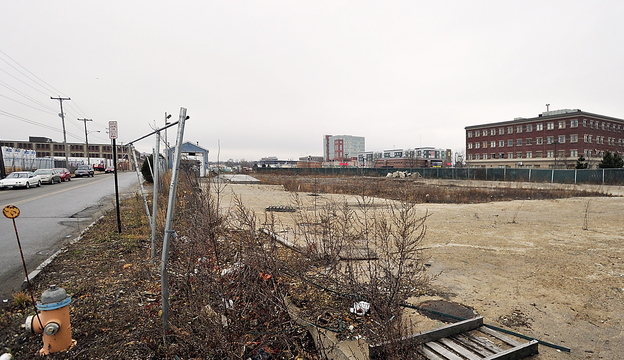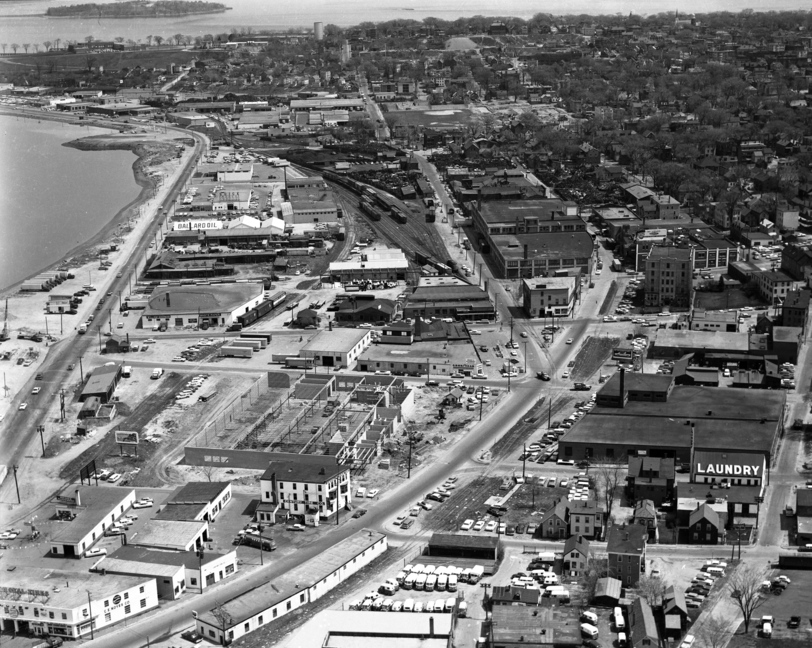For the last 50 years, residents and city officials have struggled to remake Portland’s Bayside neighborhood.
While many want it to be a shiny gateway to the city, it’s still trapped in the shadow of its industrial heritage.
The struggle will continue on Tuesday when the Planning Board could approve a master plan for four high-rise buildings, retail space and two parking garages on city-owned land along Somerset Street. Construction would begin early next year on the first phase, a 15-story tower of market-rate apartments and a 705-car garage, said Greg Shinberg, the local representative for the Miami-based developer, The Federated Cos.
The proposal has divided a neighborhood already at a crossroads. One side desires small, incremental change, while others hope the ambitious project will prove to be a silver bullet.
It wouldn’t be the first transformation for Bayside.
“It’s an area of the city that — since its inception — has always been an area of change,” said state historian Earle Shettleworth.
THE BEGINNING
Bayside is roughly 100 acres bounded by Marginal Way, Franklin Street, Cumberland Avenue and Forest Avenue. It’s nestled between Interstate 295 and downtown, making it a gateway to the city.
Much of Bayside didn’t exist until the mid-1800s, when Charles Q. Clapp, a local developer, began filling in Back Cove with earth taken from Munjoy Hill.
Before that, Back Cove nearly reached up to Oxford Street and into Deering Oaks. The Deering Bridge, which no longer exists, spanned an estuary that is now Forest Avenue.
Clapp filled in about 11 acres north of Oxford Street in 1850 with the vision of building piers and a dam, Shettleworth said. The steep banks overlooking Washington Avenue are a testament to that effort, he said.
Most of Bayside today was in a section of Back Cove filled with debris from the Great Fire of 1866 — which burned most of the Old Port. More fill was added in the 1960s to build Interstate 295.
A rail yard was built along Somerset Street shortly after the area was filled, and a street car ran along Oxford Street.
ERA OF STABILITY
Over the decades, Bayside established two identities. It was an industrial center of Maine — connected to immigrant labor and a relatively large and active rail line and seaport. It was also a burgeoning melting pot of new Americans — a diversity that is still reflected there today.
Bayside, which has also become known as West Bayside, was the industrial zone, with foundries, lumber companies, soldering shops and junkyards.
East Bayside was a lower middle class neighborhood where immigrants settled. It spans from Franklin Street to Washington Avenue.
The Irish were among the first to settle there, followed by Scandinavians in the 1880s, Eastern Europeans in the 1890s and more recently African and Middle East refugees.
“It all became a melting pot after 1900,” Shettleworth said, noting the arrival of Jews, Italians and Greeks.
URBAN DECLINE
The landscape changed in the 1960s when roughly 155 buildings were demolished to make way for Franklin Arterial and the housing project now known as Kennedy Park. Also built in the 1960s was the 16-story Franklin Tower on Cumberland Avenue.
Another 110 homes and businesses were demolished as part of the city’s “slum clearance” program.
The lack of homeowners and increase in social services, such as homeless shelters, made Bayside a rough neighborhood through much of the 1980s and 1990s. Some buildings were abandoned and became frequent hangouts for the homeless and vagrants.
Rob Spinella, however, saw potential and bought a house on Cumberland Avenue nearly 20 years ago. He now owns three buildings and is an active member of the community.
“Bayside had been hollowed out by fires in the 1970s and neglect in the 1980s,” he said.
Spinella moved to Bayside around the same time it was named the second “worst white underclass neighborhood” by U.S. News and World Report, which examined 15 cities. The neighborhood placed second behind South Boston because of its high teen pregnancy rate.
Steve Hirshon said he and his wife moved to Hanover Street 22 years ago because housing was cheap. Despite the problems, Hirshon said Bayside was still “a very nice neighborhood (with) people from all walks of life.”
At the same time, racial tensions between whites and newly arriving African refugees led to neighborhood clashes. Groups of white kids threw bricks into windows of the homes of African immigrants. There were street brawls and a home invasion in which white youths attacked sleeping African immigrants with baseball bats.
“You could feel (the neighborhood) had gone through some bad times, but the spiraling down had come to end,” Spinella said. “We’re still repairing and mending the neighborhood.”
NEW VISION
The Bayside Neighborhood Association was formed to help ease racial tensions, which also prompted city police and planners to actively address the issues plaguing Bayside — namely vacant lots and buildings, and the presence of scrap yards. Scrap yards have been a presence in Bayside for nearly 100 years.
In the late 1990s, city leaders teamed up with residents to draft “A Vision for Bayside.” Published in 2000, it envisioned five interconnected districts: a mixed-income neighborhood, a corporate enclave, consolidated social services, a funky village and larger highway-oriented hospitality businesses.
Despite early enthusiasm for the vision, the patterns of development fueled by the private market have not strictly followed to the plan, leading to frustrations among neighborhood leaders. One major departure — and a major source of friction with the pending development proposal known as “midtown” — is the prevalence of surface parking lots, which conflicts with the plan’s focus on walkable and bikeable neighborhoods with robust public transit options.
“The development has been more suburban,” Hirshon said of the prevalence of surface parking. “Developers are just a little reluctant to embrace urban sensibilities.”
SLOW DEVELOPMENT
Ross Furman, a principal at Lincoln Capital, has been doing business in Bayside since he founded Skillful Vending in 1976 and owns property on numerous streets in the neighborhood. The Portland native moved from Falmouth Foreside to a renovated bungalow on Brattle Street three years ago.
“There isn’t much real Portland left,” Furman said. “Down here is the last frontier for the peninsula of Portland.”
Furman says Bayside’s slow, organic growth has been a good thing.
“It has evolved, basically through local people making things happen themselves rather than people from out of town making it into a mecca,” Furman said.
Development activity began picking up in the late 1990s.
In 1998, Peter Quesada’s office building on Marginal Way for the state’s Department of Health and Human Services was the first office building built downtown in 10 years.
A year later, the city started offering developers up to $600,000 to build affordable housing in Bayside. Developer Richard Berman won a bid and built 33 units of affordable houses, now called Unity Village, on two Stone Street parking lots once used by City Hall employees.
A few years later, the city sold land on Marginal Way so that Bayside Village, a privately run student housing development, and the Intermed office building could be built next to I-295.
In 2008, Avesta Housing began developing Pearl Place — a two-phase project that now includes 114 units of affordable housing.
And rather than having transit-oriented developments that rely on walking, biking and public transportation, surface parking lots dominate the landscape around new developments, such as Whole Foods, The AAA Building and Gorham Savings Bank.
FALSE STARTS
There has been no shortage of ambitious development plans that carried the promise of remaking Bayside from an industrial wasteland into a first-class gateway to the city.
In 1999, the city turned down an offer from the Libra Foundation, which offered to donate 6.6 acres and millions of dollars to build a new arena to replace the Cumberland County Civic Center. The following day, Quesada pulled the plug on a project to build a new store with an outdoor cafe and atrium for Bookland.
The following year, Idexx Laboratories received a $33 million tax break from the city, which also promised $10 million in state and federal loans, to move forward with a 24-acre expansion in Bayside. But it ultimately decided to stay in Westbrook.
When a mutual fund company turned away from Bayside because of the scrap yards, the city made a concerted effort to eliminate them.
The city increased environmental guidelines for scrap yards and eventually bought 50 acres of land on Riverside Street and relocated one of the two junkyards there.
However, whatever momentum was gained by moving one of the junkyards was squashed by the recession.
A 2007 plan to build a 64-unit apartment building, a parking garage and office space on city-owned land on Somerset Street collapsed for lack of tenants and financing.
The following year, MaineHealth and the United Way of Greater Portland received approvals to build a new headquarters and parking garage on that same city parcel. But in 2009, MaineHealth pulled the plug, blaming the recession and tightening financial markets.
TODAY
On Tuesday, residents will be given the chance to weigh in on “midtown,” the next best promise for Bayside.
Even supporters, who acknowledge the plan is not perfect, are cautiously optimistic that the project — if approved by the Planning Board — even may defy history and actually come to fruition.
“Hope reigns supreme,” Spinella said.
Randy Billings can be contacted at 791-6346 or at:rbillings@pressherald.comTwitter: @randybillings
Send questions/comments to the editors.





